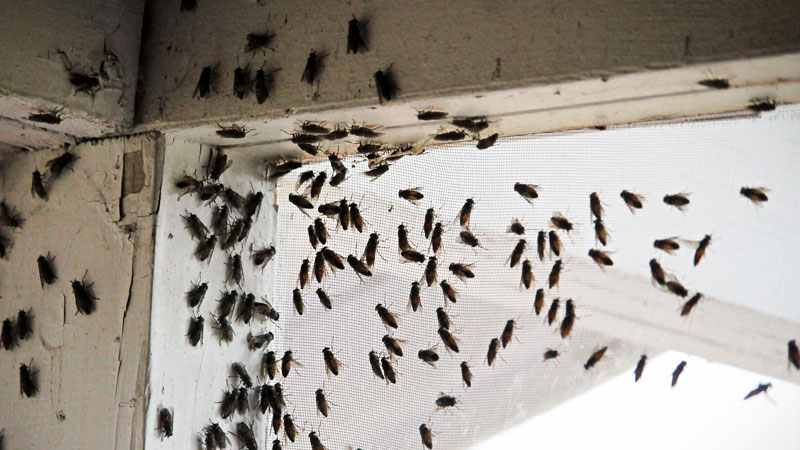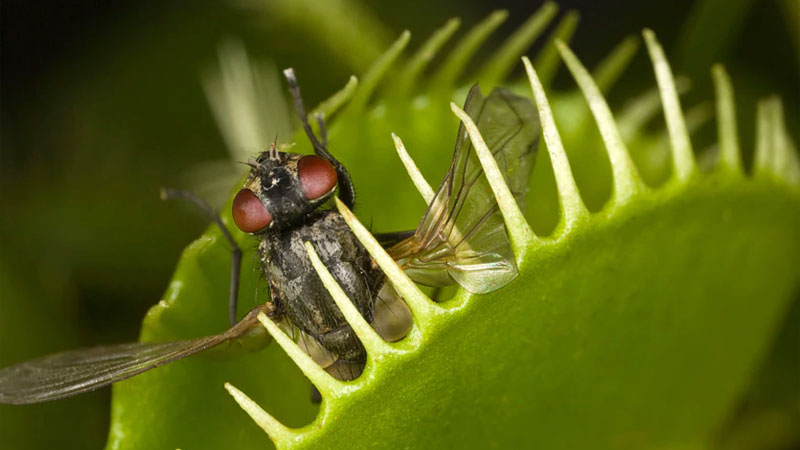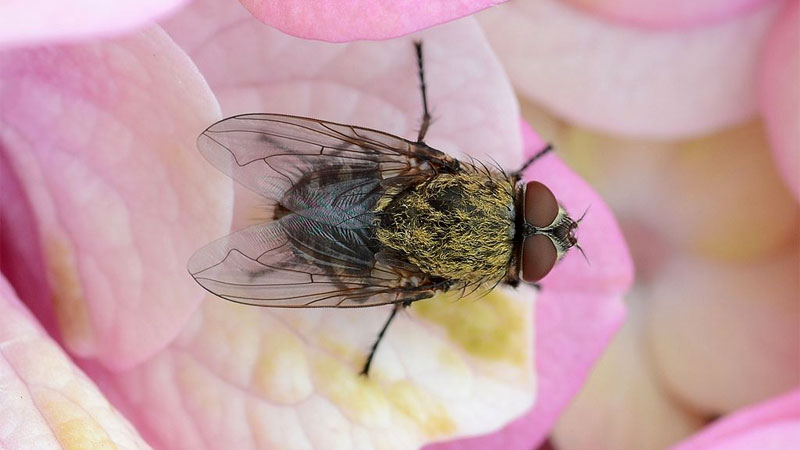You wouldn’t expect flies to be a problem in the winter, but here they are, a large number of flies hanging around in the house all of a sudden. It looks like something straight out of The Amityville Horror, with flies all over the window frames and blotting out the sunlight. But every time you get rid of the cluster flies, they just come back.
True, these large pests are just as genetically unable to fly out an open window as their cousins, the house fly, and love to amass on your windows. However, there are ways to get rid of them. Let’s look at those methods, as well as how to make sure the critters you’re dealing with are actually cluster flies.
Getting to Know Cluster Flies
These members of the fly family get their name because they tend to congregate in clusters. They’re better known in the scientific community as Pollenia rudis. While normally outdoor bugs, they like to migrate into your home as the weather gets colder.
Cluster flies are far less of a health hazard than other fly species, although their poop and lackadaisical attitude can make them quite an annoyance and they don’t serve much of a purpose.
Identifying a Cluster Fly
It isn’t difficult to spot these pests, as they’re flies that fly in circles lazily, instead of zooming about in more random patterns like many other fly species. Appearance-wise, they’re large dark grey flies with silvery-black markings and overlapping wings. They have distinctive golden hairs on their thorax which helps identify them from similar species.
You’ll usually find them in groups hanging out on your windows when it’s sunny. However, they’re also known to congregate in the attic, basement, or even within wall voids. This behavior has also earned them the nickname “attic fly”.
See Also: How to Get Rid of Fruit Flies
How Long do Cluster Flies Live?
Due to the way cluster flies hibernate when the weather drops below 54 degrees, it can seem like they live quite a long time. However, a cluster fly typically only lives one to two months.
The reason you see them in your home at various points in the winter is largely because your furnace settings are enough to wake them up.
Related: Where Do Spiders Go in the Winter?
Cluster Fly Life Cycle
When a female emerges from hibernation (or is otherwise ready), she will lay eggs in soil where earthworms are active. However, she places them in cracks in the soil ssurface rather than injecting them. The eggs hatch in about four days and the maggots begin to search for earthworms.
Once a worm is found, the cluster fly larvae burrows into it and begins feasting. After 13 to 22 days, the maggot molts and enters the pupal stage, nestled safely in the soil until it emerges as a full adult 11 to 14 days later.
There are usually four generations of cluster fly during the summer months, and three to four during spring and autumn. As cluster flies only lay eggs outdoors, the number of winter generations relies heavily upon outdoor temperatures.
See Also: Will Bleach Kill Maggots?
Why Cluster Flies Are Unusual
Normally, we’d tell you about all of the diseases or damage caused by a pet, but cluster flies are different. They carry no known transmittable diseases, have no mouth parts that would allow them to bite, and pose no risk of structural damage to your home.
In fact, their diet is strictly earthworms, so they’re not even interested in human food. About the only health issue cluster flies contribute to is anger or stress issues when you’re trying to get rid of them.
When Cluster Flies Become Problematic
Of course, that doesn’t mean cluster flies are pleasant guests, especially in the winter months. They leave their excrement on windows. Dead cluster flies attract arachnids, roaches, and other bugs. Large cluster fly populations can really cut into your sanity.
Worst of all, cluster flies are a true nightmare for those who practice vermiculture. Their precious composters become living earthworm hosts, doomed to be eaten alive by these pests.
Cluster Fly vs Bottle Fly
The bottle (or blow) fly is much larger than cluster flies and significantly faster. You can easily tell the two apart by the metallic sheen of a blow fly vs. the dull colors and yellowish thoraxial hairs of the cluster fly.
Cluster Flies vs House Flies
It’s easy to mistake any large fly for a house fly, but cluster flies are visibly different. Their silvery markings help set them apart from the smaller housefly, which are large black flies with dark stripes.
When they’re not busy getting on your nerves, a house fly’s wings touch, whereas a cluster fly’s overlap. Also, a house fly is much faster than cluster flies, who seem to believe they’re on a grand tour and forgot the camera.
See Also: How to Get Rid of Horse Flies
How to Get Rid of Cluster Flies Naturally
You don’t need to resort to a full-blown extermination when a cluster fly infestation happens. However, when you kill cluster flies, you need to be careful to clean up the corpses quickly or you could attract far more problematic critters.
Here are a few easy methods, some of which you probably have the materials for already.
Carnivorous Plants
One of our favorite bug control methods, carnivorous plants are a cross between a pet and houseplant. They attract a wide range of insects, from fruit flies and hoverflies to gnats, and dissolve the corpses, meaning no need for cleanup.
Pitcher plants and venus flytraps are the two most popular species and can sometimes be found in various stores such as Target or Busy Beaver in the gardening section.
Cluster Buster
The Cluster Buster a trap designed especially for cluster flies and as such is one of the best cluster fly traps out there. The walls are translucent, so when you attach it to a sunny window, the light shines through and attracts the flies.
Inside is finely ground eggshell, which acts like quicksand, pulling the fly under and clogging their respiratory systems. As with everything in our list, these traps are non-toxic and each one will last up to four years (or 1,000 flies).
Light Traps & Zappers
Cluster flies are attracted to light and heat, so bug zappers (like this one) work really well against these critters. They fly up to the bulb and are instantly electrocuted. It’s a safe method that isn’t strong enough to harm pets or humans, although it can still give a nasty shock if you touch the inside of the trap.
Light traps, like the popular Katchy model, are very similar to their electronic forebears, only the light is surrounded by a sticky cardboard that traps the flies instead of electrocuting them.
The strips need to be replaced occasionally and can be a pain to wash off of a cat’s fur if they get stuck. Still, it’s inexpensive and non-toxic, so investing in one could be a good solution.
Pyrethrin-Based Aerosol Insecticides
Made from natural plant extracts, this insecticidal spray is safe for use around the house and won’t harm your pets (unless you have insect pets, of course).
This method has a high degree of success, providing the flies are at rest or you have good aim. Just be sure to clean up any corpses to prevent attracting other insects.
Note also that some pyrethrin products are residual insecticides. These can be sprayed around electrical outlets or window frames and remain effective for a while after application. Be sure to check which type your spray is before using it for this purpose.
See Also: Best Fly Sprays for Horses
Bug-a-Salt
We here at RMC all love our Bug-a-Salt arsenals, and sometimes hold remote competitions. But while they work well for some flying insects, most cluster flies are a bit too large to kill with a salt gun.
You can try but you’ll likely only stun them – which can be all you need to net them for a pet lizard if you’re quick.
How to Keep Cluster Flies Out
When it comes to dealing with a swarm of flies, it’s easier to not get them in the first place. This can be tough when it comes to cluster flies, as they can squeeze through very small spaces.
Thankfully, whatever gets in is all you’ll have to deal with when it comes to these particular flies. Here are a few steps to keep cluster flies (and many other critters) from getting into your home.
Cracks and Crevasses
Take a tour around your home a few times per year looking for signs of wear and tear. You should apply fresh caulk to seal cracks around window and door frames as needed to eliminate breaks.
Additionally, sealing up cracks along eaves, siding, utility pipe entrances, etc. will also go a long way towards eliminating any entry points and stop common houseflies, spiders, or even sweat bees from invading your home.
See Also: How to Keep Flies Out of Your Garage
Screens
When it comes to windows and doors, you should always have screens installed. Check a few times per year for signs of damage, as holes can defeat the purpose of a good window screen.
Remember, flies may be genetically incapable of flying out of an open window, but they’re very good at finding their way in.
- How to Get Rid of Hawks - March 8, 2024
- How to Get Rid of Pill Bugs (Rolly Pollies) - March 1, 2024
- How to Get Rid of Groundhogs (Woodchucks) - February 5, 2024



 Just tell me how to get rid of ’em.
Just tell me how to get rid of ’em.


How should one handle lawn treatment to control their reproduction? I can’t seem to find any information talking about treating lawn to interrupt their life cycle. Wood ash? Diatomaceous Earth? Lawn insecticide?
I think nematodes would work, but i am still researching